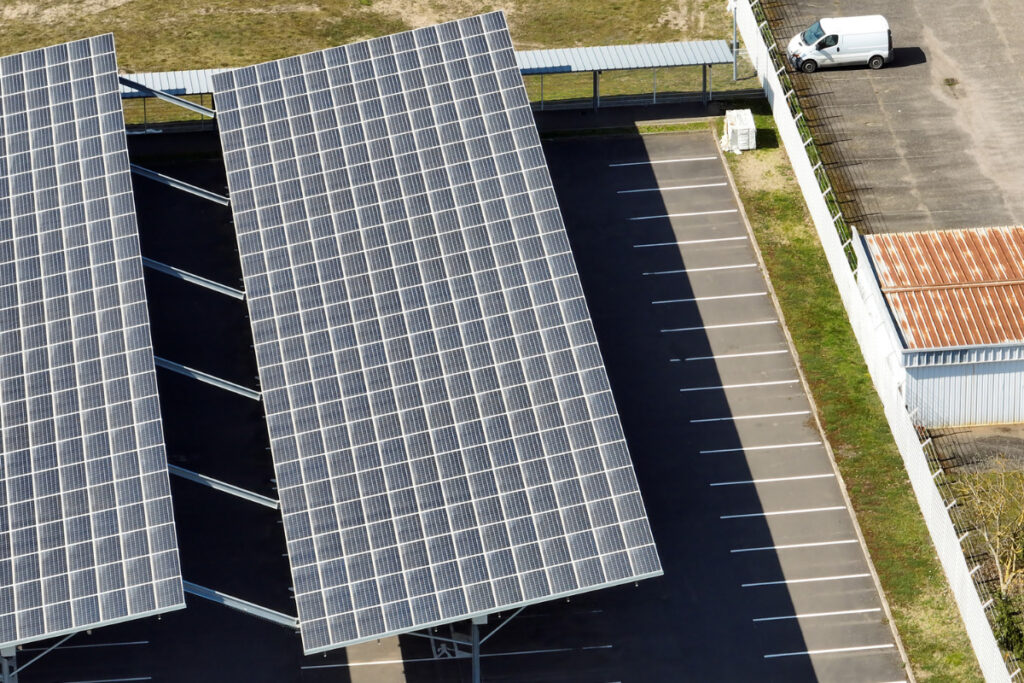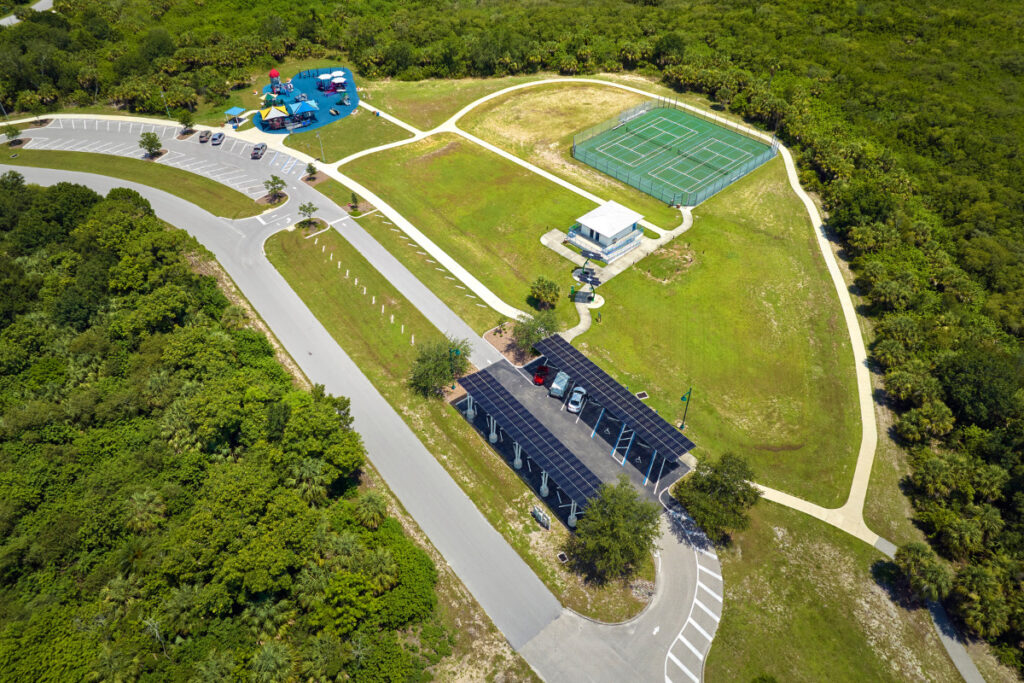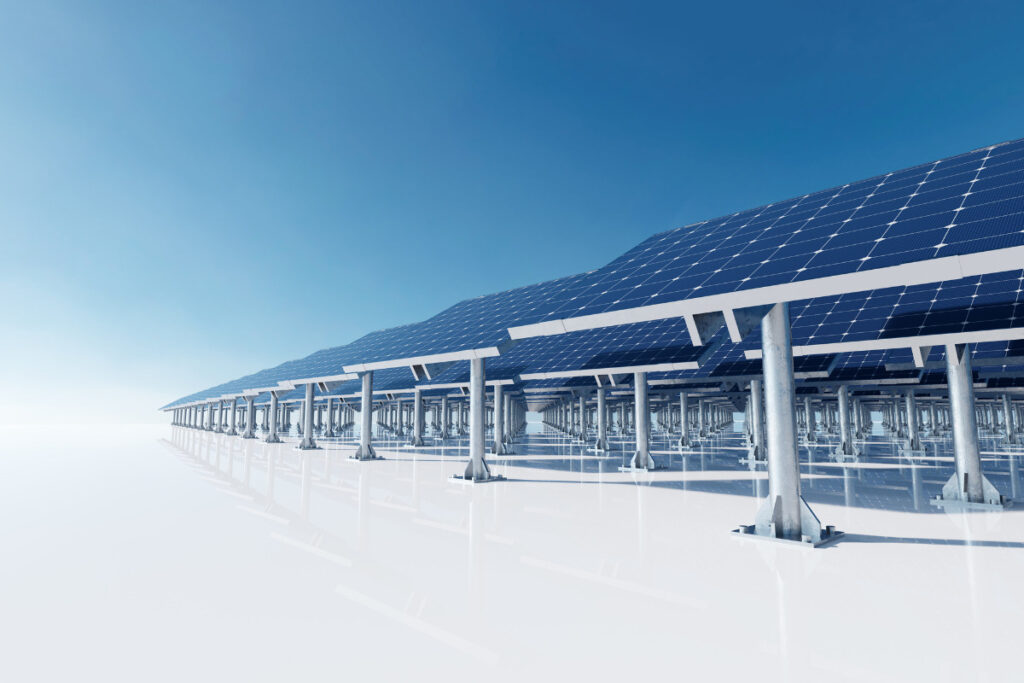Introduction
Imagine transforming vast, underutilized parking lots into clean energy powerhouses that promote sustainable living and combat climate change. That’s the potential of solar canopies in parking lots – an innovative, eco-friendly solution to harnessing renewable energy.
These ingenious structures provide shade for vehicles and generate clean electricity from the sun.
In this blog post, we will explore how these canopies revolutionize our thoughts about sustainable energy. We’ll discuss practical applications, challenges, and opportunities for broader implementation.
| Key takeaways |
|---|
| Solar canopies in parking lots are innovative structures that combine the functionality of conventional parking lot shade with the ability to generate clean, renewable energy. |
| These photovoltaic systems provide a practical solution for balancing power grids during peak demand periods and offer cost-effective benefits, revenue generation opportunities, and reduced carbon emissions contributing to climate change. |
| Successful installations at universities, businesses, and public spaces worldwide have allowed them to reduce their carbon footprint while producing clean energy. Financial incentives like Renewable Energy Tax Credits (RETCs) incentivize individuals or businesses by reducing installation costs while encouraging sustainable energy use. Factors such as orientation and tilt of panels need consideration before installation. |
Understanding Solar Canopies In Parking Lots
Solar canopies in parking lots incorporate photovoltaic panels to generate clean and sustainable energy while providing shade and protection for parked cars.
Definition And Characteristics
Solar canopies are photovoltaic (PV) canopies or solar carports. They are innovative structures that generate clean energy and provide parking lot shade.
These modern installations are typically made of steel frames and solar panels.
One significant characteristic of solar carports is their adaptability and versatile design possibilities. They come in various sizes and configurations that cater to the specific needs of a location – from single-row arrays covering individual parking spaces to vast multi-row installations spanning large parking lots.
Many solar canopy systems also incorporate additional features such as integrated LED lighting for enhanced safety at night and electric vehicle charging stations to further promote sustainable transportation options.
How It Works
Solar canopies installed in parking lots function much like traditional solar panels but with added benefits. These photovoltaic systems comprise several interconnected solar panels that generate electricity from the sun’s light. Transforming solar energy into usable power that is either stored in batteries or distributed to the grid.
Solar canopies serve as an effective solution for balancing power grids by storing extra electricity generated during off-peak hours in batteries. This guarantees renewable energy availability throughout the day.
Integrating solar canopies on parking lots offers companies and institutions sustainable options to reduce carbon footprints and improve urban sustainability.
Cost-Effectiveness And Revenue Generation
Solar canopies in parking lots offer a sustainable energy solution and provide cost-effective benefits and revenue generation opportunities. Installing solar panels on parking canopies helps reduce traditional energy costs, providing long-term savings for businesses and individuals.
Solar canopies save costs and generate revenue by returning excess energy to the grid. They reduce carbon emissions and dependence on non-renewable sources.
Moreover, photovoltaic canopies integrate well with parking lots, providing economic and environmental benefits. They support sustainability goals in both urban and rural areas.
Eco-Friendly Solution For Sustainable Energy
Solar canopies in parking lots offer an eco-friendly solution for sustainable energy, reducing carbon footprints and heat island effects while generating clean energy and balancing the grid.
Reducing Carbon Footprint And Heat Island Effect
Solar canopies in parking lots are an eco-friendly solution that generates clean energy and helps reduce a community’s carbon footprint. Using solar energy can significantly decrease our dependence on fossil fuel-based power plants, which contribute to greenhouse gas emissions and global warming.
Furthermore, placing solar panels in parking lots reduces the heat island effect. Cities experience hotter temperatures than rural areas due to the large number of concrete surfaces that trap heat during the day and release it at night, making urban spaces feel more desirable than they actually are.
For example, Rutgers University installed a 32-acre solar carport canopy that produces about 8.8 units of electricity annually and provides shaded areas for parked vehicles.
Investing in renewable energy solutions like solar canopies on parking lots can create a more sustainable future with less pollution and reduced environmental impacts.
Generating Clean Energy And Balancing The Grid
One of the significant benefits of installing solar canopies in parking lots is generating clean energy and balancing the grid. Solar panels on these canopies absorb sunlight, transforming it into electricity that powers nearby buildings or electric vehicles.
Moreover, when excess power is generated by these panels, it’s fed back into the grid system. As more companies shift to renewables, extra energy feeds into the grid, balancing demand.
For instance, Rutgers University’s 32-acre solar carport produces 8.8 million kWh annually. This meets two-thirds of its power needs while cutting 60% of its carbon footprint.
Solar canopies provide eco-friendly solutions, converting sunlight into energy and reducing dependence on fossil fuels for cars, lighting, and heating.
Practical Applications Of Solar Canopies
Solar canopies have numerous practical applications in both commercial and residential settings. From business districts to universities, public spaces, and residential areas, solar canopies offer a versatile, cost-effective, eco-friendly, renewable energy solution.
In Business Districts, Universities, Public Spaces, And Residential Areas
Solar canopies in parking lots are versatile and can be installed in various locations, including business districts, universities, public spaces, and residential areas. Here are some examples of how solar canopies are being used in different settings:
Business districts: Solar canopies in parking lots of high-rise buildings and office complexes can generate clean energy to power the building’s operations. In addition, they can provide a source of revenue by selling excess power back to the grid and offering electric vehicle charging stations.
Universities: Many universities have large parking lots that offer ample space for solar canopies. The generated electricity offsets some of the university’s energy consumption.
Public spaces: Solar canopies in public parks or other outdoor recreational areas help reduce carbon footprint while providing shade for park visitors. They also offer an opportunity for local governments to promote sustainable practices and lead by example.
Residential areas: Homes with electric vehicles (EVs) could install solar carport systems that would allow them to generate clean energy for their EVs. These systems might sometimes involve installing battery storage systems that permit homeowners to store excess energy on sunnier days or use it during times when the sun isn’t shining as bright.
Solar carports have many benefits, such as shade and protection from inclement weather. They also reduce the heat island effect, which lowers ambient temperatures. These benefits complement the production of clean energy. By combining renewable energy with functional infrastructure like parking lots, we see great opportunities across urban sustainability efforts right now!
Successful Examples Of Solar Canopies And Their Impact
Several businesses, universities, and public spaces have already used solar canopies on their parking lots. For example, the University of California has installed over 11 megawatts of solar carports across nine campuses to achieve carbon neutrality by 2025.
Similarly, Kaiser Permanente installed a massive solar canopy at their regional headquarters in California that not only produces clean energy but also provides shade for parked cars.
Moreover, Tesla’s Supercharging stations feature covered charging ports with solar panels that generate clean energy to power electric vehicles while shading parked cars from the sun.
The impact of these successful installations speaks for itself: they consistently reduce carbon emissions while providing shade and producing clean energy for immediate use or even feeding into local grids.

Overcoming Challenges And Moving Forward
Factors such as cost-effectiveness and practicality must be considered to overcome the challenges of installing solar canopies, and public awareness should be raised. At the same time, policies and incentives are implemented for wider adoption.
Factors To Consider When Installing Solar Canopies
Before installing solar canopies in parking lots, several factors should be considered to ensure their effectiveness and efficiency. These factors include:
- Orientation and Tilt: Proper orientation and tilt of the panels are essential for maximizing energy production. The angle of the panels should be optimized based on the location’s latitude and seasonal changes.
- Location: Choosing an optimal location with optimum sun exposure is crucial as it directly affects the performance of solar canopies. Factors like shade from trees or buildings and weather patterns should also be considered.
- Design Strength: To ensure safety and durability, solar canopies must be designed to withstand harsh weather conditions such as strong winds, heavy snow loads, or hail storms.
- Grid Connection: Connecting solar carports to the electric grid allows excess power generated to be stored or transmitted back into the grid, making them more effective in offsetting energy costs.
- Maintenance Requirements: Proper cleaning, routine checks, timely maintenance, and repairs are imperative for keeping solar canopies operational at peak performance.
- Financial incentives: Renewable Energy Tax Credits (RETCs) incentivize businesses and individuals through tax deductions or rebates to install solar canopies by reducing installation costs while encouraging sustainable energy use.
Individuals and businesses can successfully implement this eco-friendly solution for generating clean energy while offsetting utility bills by considering these critical factors for installing solar canopies.
Increasing Public Awareness, Policy Changes, And Incentives
The transition to sustainable energy requires a collective effort from all stakeholders, including individuals, businesses, and governments. Increasing public awareness through education campaigns and outreach programs is one way to encourage the adoption of solar canopies in parking lots as an eco-friendly solution for generating clean energy.
For instance, California’s Solar on Multifamily Affordable Housing (SOMAH) program offers incentives to affordable housing developers who install solar panels on their buildings’ roofs.
This program enables residents in low-income communities to access clean energy while reducing their electricity bills. Similarly, New York City’s Solarize NYC campaign encourages property owners to switch to solar power by offering free site assessments and discounted installation costs.
Ultimately, adopting solar carports in parking lots requires a shift in mindset towards embracing renewable resources rather than relying solely on non-renewable sources.
Innovations In Technology And Future Developments
Solar canopy tech improves efficiency and affordability, enabling widespread adoption across diverse industries.
For instance, energy storage systems can store excess energy and distribute it when needed, optimizing output.
Additionally, smart tech tracks energy production/consumption, aiding informed usage decisions for businesses.
Future photovoltaic canopies are also integrated with building designs for aesthetic appeal.
Conclusion And Next Steps For Utilizing Solar Canopies In Parking Lots
In conclusion, solar canopies in parking lots offer a practical and environmentally-friendly solution for sustainable energy that can benefit businesses, universities, public spaces, and residential areas.
Encouraging wider adoption of solar carports will require increasing public awareness, policy changes, and incentives to promote the transition to alternative energy.
The Potential Of Solar Canopies For Sustainable Energy
Solar canopies have the potential to revolutionize sustainable energy solutions. By installing solar panels on parking lots, we can reduce our carbon footprint and generate clean energy while providing shade for cars.
Solar carports’ have numerous benefits – they help balance the grid, increase tax savings, and provide a more eco-friendly solution to powering electric cars.
With technological advancements, solar canopy installations will continue to become more cost-effective and efficient, encouraging wider adoption across industries.
Encouraging Wider Adoption Of Solar Canopies
To encourage the wider adoption of solar canopies in parking lots, it is crucial to increase public awareness about the benefits of sustainable energy and incentivize businesses and individuals to take action.
Successful examples of solar canopy installations in public spaces, universities, and business districts could inspire others to follow suit. Moreover, technological innovations such as energy storage systems and industry electrification options make it easier for people to transition toward clean power sources.
The Role Of Businesses, Governments, And Individuals In The Transition To Sustainable Energy
The transition to sustainable energy requires the efforts and participation of businesses, governments, and individuals. Companies are important in investing in clean energy solutions to encourage wider adoption of these on parking lots.
Investing in renewables increases access to affordable energy while reducing carbon emissions. Individuals can reduce their carbon footprint by supporting eco-friendly initiatives and policies.
Ready to go solar? Contact DroneQuote!
Don’t miss the opportunity to participate in the sustainable energy movement! Solar canopies have the potential to transform parking lots into clean energy powerhouses, and you can be a part of it. With the help of DroneQuote, your trusted solar partner, you can take the first step towards a cleaner future by exploring solar canopies’ benefits and practical applications.
Join us in promoting sustainable living and combatting climate change with this innovative, eco-friendly solution. Contact us today to get started on your solar canopy project.

FAQ
- What are solar canopies in parking lots, and how do they work?
Solar canopies in parking lots are structures equipped with solar panels installed on top of them that generate electricity from the sun’s energy. They provide a cost-effective, eco-friendly solution to create sustainable energy while providing shade and shelter for parked cars.
- How much energy can be generated by installing solar canopies in parking lots?
The amount of energy generated depends on various factors. These factors include canopy size, location, orientation, and weather conditions. However, typically an average-sized installation may produce enough power to offset around 30% of a building’s electricity consumption.
- What are some benefits of installing solar canopies in parking lot areas?
Besides the environmental benefits, installing these provides additional advantages. Promoting renewable energy sources improves branding and reduces carbon footprints. Fewer greenhouse gas emissions enhance the quality of air. Non-renewable sources like fossil fuels emit more.
- Is it expensive to install solar canopies compared to other renewable energy options?
Compare the long-term savings of solar panels to non-renewable resources. Consider the economic risks of non-renewables, like fluctuating oil prices. Governments offer incentives like subsidies and tax credits for alternative energies. This makes them financially feasible in the early stages. Advancements will lead to a sustainable future with reduced carbon footprints.



